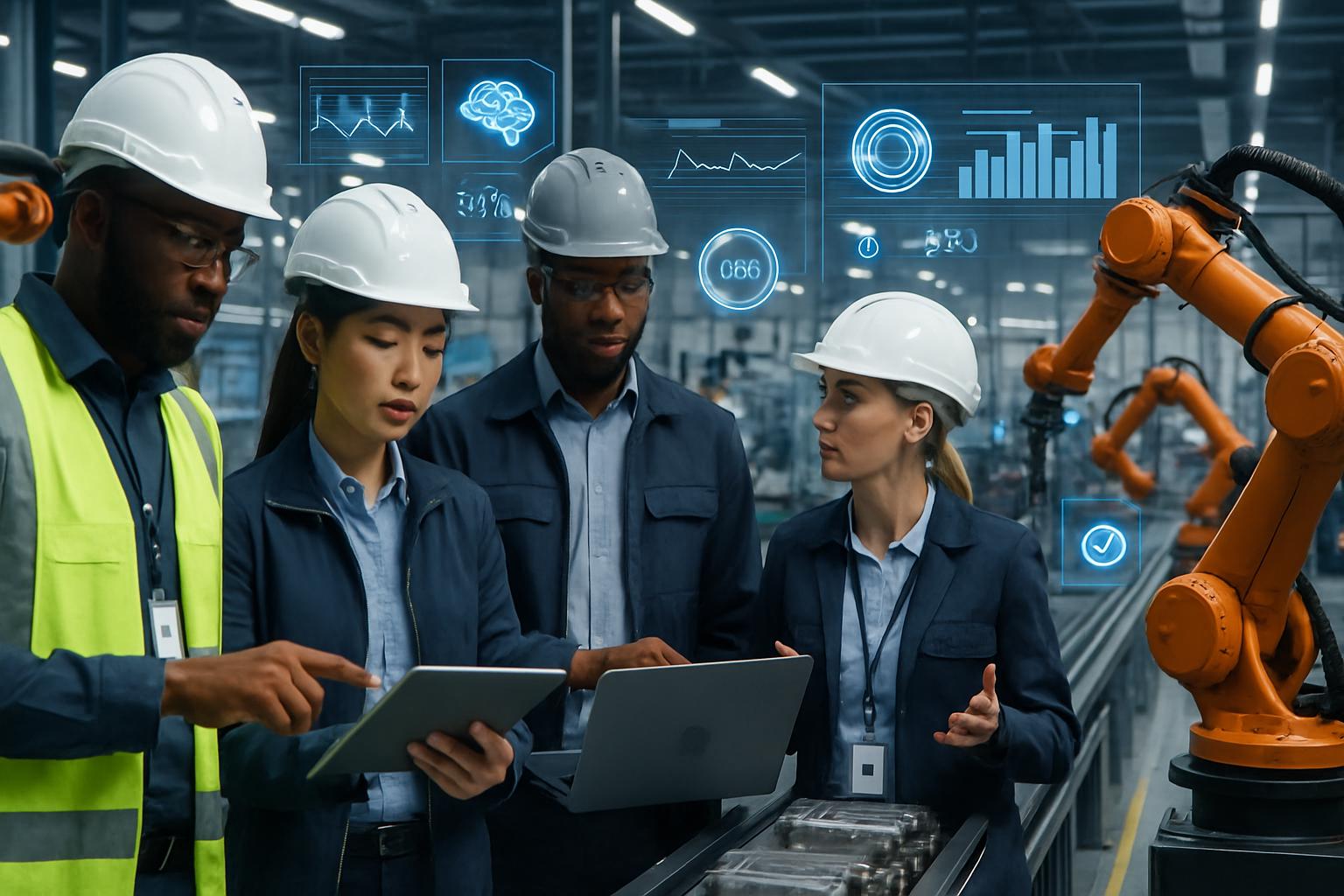
AI CERTS
2 days ago
Foxconn-Intrinsic Advance Industrial Automation AI Factories

Industry observers call the partnership a pivot from rigid automation toward reusable, AI-driven workcells.
Consequently, executives argue the move will accelerate high-mix production, where manual assembly still dominates.
Moreover, Foxconn plans to integrate the new cells across 230 global campuses after proving success in America.
Analysts highlight that Foxconn controls about forty percent of electronics manufacturing services, magnifying potential impact.
Meanwhile, the International Federation of Robotics reports 4.28 million robots already operate worldwide, underscoring fertile terrain.
Still, success demands rigorous validation of Intrinsic's vision model and robust workforce strategies.
The following analysis unpacks motivations, technologies, challenges, and opportunities shaping this ambitious collaboration.
Furthermore, it positions Alphabet's Intrinsic to commercialize research beyond labs, confronting rivals like ABB and FANUC.
Investors therefore view the venture as a strategic wedge into the booming smart-factory market projected at $141 billion by 2027.
Industrial Automation AI Significance
Smart factories depend on data, adaptable robots, and rapid iteration.
Industrial automation AI supplies the learning layer that coordinates those elements.
Consequently, production lines shift from rigid sequences to software-defined operations that update overnight.
In contrast, earlier systems required months of retooling to accommodate minor design changes.
These shifts promise shorter product cycles and reduced capital waste.
Next, we examine how the Foxconn-Intrinsic partnership intends to capture that promise.
Joint Venture Strategic Overview
Foxconn will contribute scale, integration expertise, and supply-chain muscle.
Alphabet's Intrinsic offers Flowstate software and the Intrinsic Vision Model for perception.
Together, the companies plan multi-phased deployments beginning in U.S. electronics plants.
Moreover, use cases include assembly, inspection, machine tending, and internal logistics.
Intrinsic CEO Wendy Tan White stressed that reusable workcells can move across product lines without extensive coding.
Meanwhile, Foxconn Chairman Young Liu framed the initiative as a pillar of the company's 3+3+3 strategy.
The strategic fit aligns software prowess with manufacturing breadth.
However, technology details matter, so the next section explores the core tools.
Key Core Technologies Explained
Intrinsic Flowstate is a cloud environment for building, simulating, and deploying robotic skills.
Developers drag and drop tasks, then test them in virtual twins before touching hardware.
Intrinsic Vision Model delivers sub-millimeter accuracy using only RGB cameras and a single CAD file.
Consequently, Flowstate and IVM aim to cut sensor costs by up to twenty-fold, according to vendor claims.
- Foxconn revenue reached USD 208 billion in 2024, underscoring deployment resources.
- IFR counts 4.28 million factory robots, mainly in Asia, signaling adoption momentum.
- Smart-factory market could hit USD 141 billion by 2027, MarketsandMarkets estimates.
- Intrinsic claims hardware savings between five- and twenty-fold versus depth sensors.
These figures illustrate why both partners invest aggressively.
Professionals can deepen expertise with the AI Robotics™ certification, which covers advanced robotics integration principles.
The technology stack appears promising on paper.
In contrast, market dynamics will determine real scaling potential.
Market Forces Driving Adoption
Exploding demand for GPUs and server hardware strains manual assembly capacity.
Consequently, manufacturers pursue factory enhancement to boost throughput without expanding headcount.
Industrial automation AI enables swift changeovers that keep pace with weekly board revisions.
Furthermore, regulatory pushes for domestic capacity encourage Foxconn to localize advanced lines inside the United States.
Alphabet's Intrinsic gains a marquee launch customer, strengthening its position against established automation vendors.
Improved manufacturing intelligence enables data-driven scheduling and predictive quality analytics.
Nevertheless, component shortages threaten deployment timelines if GPU or sensor supply tightens unexpectedly.
Market pull appears strong, yet obstacles remain.
The next section reviews those challenges and needed validation.
Challenges And Validation Needs
Skeptics question whether Intrinsic Vision Model meets sub-millimeter specifications under harsh factory lighting.
Therefore, independent benchmarks covering cycle time, repeatability, and downtime will be essential.
Manufacturing intelligence dashboards must also integrate with Foxconn's existing MES and ERP layers.
Moreover, successful robotics integration often hinges on expert systems integrators and robust change-management programs.
In contrast, hard automation failures can idle lines, wasting millions daily.
These concerns highlight the importance of measured pilots and transparent reporting.
Subsequently, workforce and policy considerations deserve equal attention.
Workforce And Policy Impacts
Foxconn employs nearly 900,000 workers during peak seasons.
Consequently, large-scale factory enhancement could unsettle labor relations without clear retraining commitments.
Industrial automation AI does not entirely eliminate jobs; it often shifts roles toward maintenance and analytics.
Nevertheless, policymakers may demand domestic content rules and skills guarantees for funded projects.
Alphabet's Intrinsic and Foxconn have yet to publish structured reskilling roadmaps.
Therefore, unions and local officials will scrutinize upcoming pilot announcements.
Proactive communication could ease social friction while protecting brand reputation.
Final outlook considerations follow next.
Strategic Outlook And Actions
Analysts expect phased rollouts, starting with small workcells and scaling after data validates performance.
Manufacturing intelligence feedback loops will inform continuous optimization across Foxconn's network.
Industrial automation AI should reach ten pilot lines before global expansion, according to internal planning drafts.
Furthermore, Alphabet's Intrinsic may license Flowstate to other contract manufacturers, diversifying revenue.
Robotics integration partners like Nvidia and ABB will likely supply simulation tools and actuators.
Consequently, ecosystem standards around data exchange and safety could emerge from the collaboration.
The venture seems positioned for impact yet must prove value quickly.
Finally, the conclusion distills actionable insights for stakeholders.
Conclusion And Next Steps
Foxconn and Alphabet's Intrinsic have ignited momentum around industrial automation AI, yet execution will define success.
Verified gains in factory enhancement and manufacturing intelligence will convince skeptics and unlock wider budgets.
Stakeholders should demand transparent metrics covering cycle time, uptime, and robotics integration costs.
Consequently, phased pilots allow teams to refine industrial automation AI algorithms before scaling across facilities.
Meanwhile, workforce programs must accompany industrial automation AI rollouts to maintain social license.
Therefore, leaders who combine industrial automation AI mastery with strategic change management will capture outsized value.
Professionals can start by earning the AI Robotics™ certification to validate skills and signal readiness.
Now is the time to evaluate pilots, request data, and position your organization for the automated future.



